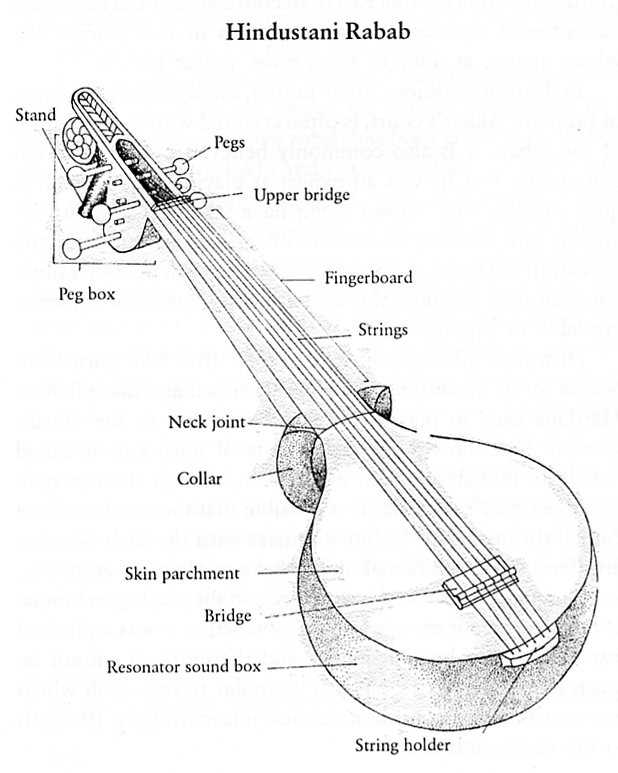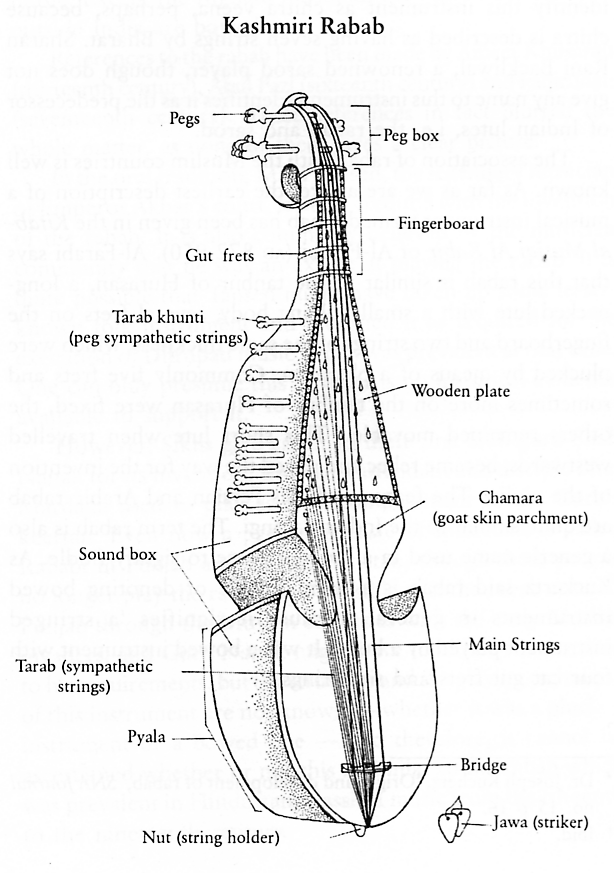Small encyclopedia with Indian instruments
The text is taken from an excerpt of Suneera Kasliwal, Classical Musical Instruments, Delhi 2001
Rabab
Rabab was introduced to the Indian classical music scene around the fourteenth and fifteenth centuries. It rose to the zenith of fame in the sixteenth century and remained there as the most popular string instrument along with the rudra veena till the eighteenth century. With the emergence of the sursingar and surbahar in the beginning of the nineteenth century, rabab and rudra veena were marginalised, and after the emergence and popularisation of the sarod and sitar in the twentieth century, both these instruments faded into oblivion.
As far as we are aware, the earliest description of a musical instrument termed rabab has been given in the Kitab- al-Musiqi Al Kabir of Al-Farabi (AD 872-950). Al-Farabi says that this rabab is similar to the tanbur of Hurasan, a long- necked lute with a small bulging body, several frets on the fingerboard and two strings of the same thickness, which were plucked by means of a plectrum. Commonly five frets and sometimes more on the tambur of Hurasan were fixed, the others remained movable. This short lute when travelled westwards, became rebec and paved the way for the invention of the violin. The features of this Persian and Arabic rabab are quite similar to the Indian sarangi.
There is another rabab called Afghani rabab or Kabuli rabab, features of which are mentioned as having a small body, and six to seven sympathetic strings. The important thing about this is that this Afghani rabab is plucked instead of bowed. This type of rabab is still prevalent in Kashmir! folk music. Except the Afghani rabab, all the other rababs played outside India are bowed.
The Seniya rabab was a plucked instrument whereas the Persian rabab, or the other varieties prevalent in middle Asian countries, were bowed. Other rababs had gut frets, but the Seniya rabab was fretless. Also it had gut strings, whereas the other rababs are described having silk strings. Seniya rabab did not have sympathetic strings whereas the Afghani rabab did. The unique feature of Indian instruments, the wide flat bridge, was present in this Seniya rabab, but the Persian and Afghani rababs had the thin violin-type bridge. However, in the later period many of these characteristics mingled with each other, but the basic structure of the Seniya rabab remained intact.
In light of these facts. Prof. Lal Mani Misra's opinion and others appears quite reasonable that the Seniya rabab was the developed and modified version of Indian string instruments, although in later stages it acquired some of the foreign traits in association with Persian and Afghani rababs. However, the similarity in names remains a puzzle. Later, the rabab paved the way for the invention of the sursingar, another favourite Seniya instrument. The ultimate culmination of the continuous association of these four instruments (three rababs and the sursingar) is the Indian sarod, which appeared on the Indian music horizon in the nineteenth century and became one of the foremost musical instruments not only in India, but also the world over.
The Seniya rabab is hollowed out of a single block of teak, tun or deodar wood. The total length of the instrument is around three to three-and-a-half feet. The resonator is round shaped and is about twelve inches in diameter, covered with goat skin. The fingerboard is around one-and-a-half feet long which tapers down into the peg box. Six pegs, three on either side, are fixed in the peg box, which is usually decorated and open. Sometimes a stand is fixed on the bottom portion of the peg box, perhaps to support the instrument. The shape of the bridge is of typically Indian character, flat and broad, made out of wood, which is fixed upon the skin-covered parchment, and all the six strings pass over it. The fingerboard is covered with a thin wooden plate. It is played with a plectrum made of coconut shell, ebony, bone or any other hard material. The names of the six gut strings are zeer, mian, sur, mandra, ghor and kharaj.
The rabab was a fretless instrument, and the strings being of gut, suffered from certain limitations and, therefore, it was more suitable for the rhythmic elaborations. Fast rhythmic patterns of madhya jod anga were characteristic to the rabab termed as lada-lapeta, lad-gunthava, kattar and tarparan. The rabab had a range of two-and-a-half octaves.
The instrument rabab was confined only to the blood relatives of the Seniya gharana, and, therefore, the need for another instrument was felt for the students outside the gharana. Gradually a new instrument called the sarod emerged on the scene.
Slowly the rabab disappeared from the music scene and by the first half of the twentieth century, it almost became extinct.

